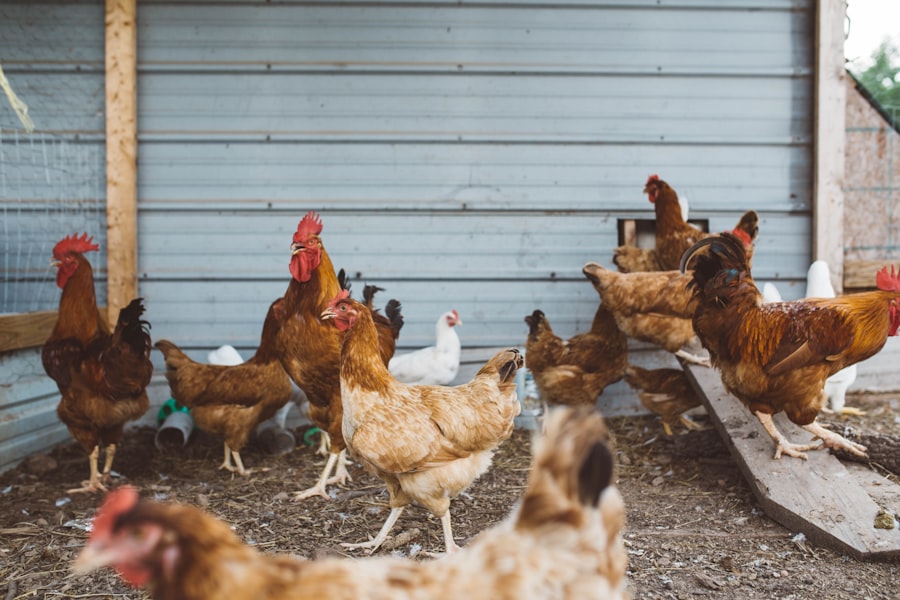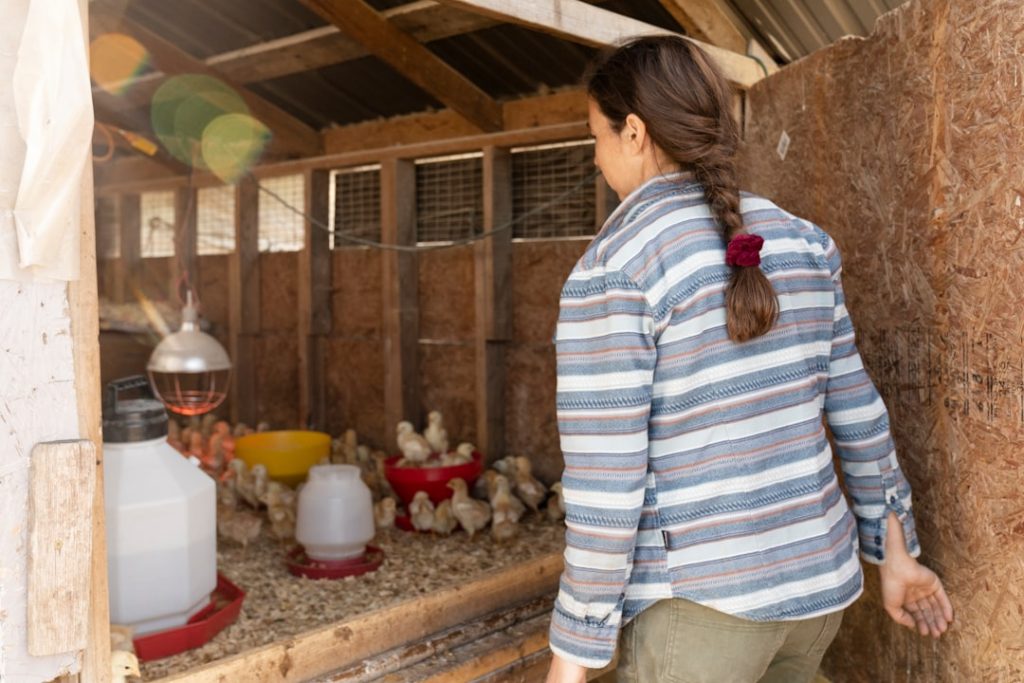Selective breeding in chickens has a history spanning thousands of years, beginning with early human civilizations recognizing the benefits of breeding chickens with desirable traits such as larger size, improved egg production, and more docile behavior. Ancient Egyptians, Greeks, and Romans practiced selective breeding for specific purposes, including meat production, egg laying, and cockfighting. As human understanding of genetics and heredity advanced, the practice of selective breeding in chickens evolved.
The 19th and 20th centuries saw more systematic and controlled breeding programs, leading to the development of specialized chicken breeds for specific purposes. In modern times, selective breeding continues to play a crucial role in the poultry industry, with breeders focusing on developing chickens that are more efficient at converting feed into meat or eggs, as well as those with increased resistance to diseases and environmental stressors. The history of selective breeding in chickens demonstrates human ingenuity in harnessing the genetic potential of these birds to meet evolving needs.
This practice has shaped the genetic diversity of chicken breeds and contributed significantly to the success of the poultry industry, from ancient civilizations to contemporary breeding programs.
Table of Contents
- 1 The Science Behind Selective Breeding
- 2 The Benefits and Drawbacks of Selective Breeding
- 3 Selective Breeding for Specific Traits in Chickens
- 4 The Impact of Selective Breeding on Chicken Welfare
- 5 Selective Breeding and the Future of Chicken Farming
- 6 Ethical Considerations in Selective Breeding of Chickens
- 7 FAQs
- 7.1 What is selective breeding of chickens?
- 7.2 How is selective breeding of chickens carried out?
- 7.3 What are the benefits of selective breeding of chickens?
- 7.4 Are there any ethical concerns related to selective breeding of chickens?
- 7.5 What are some examples of selectively bred chicken breeds?
Key Takeaways
- Selective breeding in chickens dates back thousands of years, with ancient civilizations intentionally breeding birds for desired traits.
- The science behind selective breeding involves identifying and selecting for specific genetic traits to create desired characteristics in chickens.
- The benefits of selective breeding in chickens include improved productivity and disease resistance, but drawbacks can include reduced genetic diversity and potential health issues.
- Selective breeding for specific traits in chickens can focus on traits such as egg production, meat quality, or feather color and pattern.
- The impact of selective breeding on chicken welfare is a topic of concern, as some breeding practices can lead to health and welfare issues for the birds.
The Science Behind Selective Breeding
Genetic Variation: The Foundation of Selective Breeding
Genetic variation provides the basis for selective breeding, offering breeders the raw material to work with. By selecting individuals with specific traits and mating them, breeders can increase the frequency of those traits in the population over time. This process relies on an understanding of dominant and recessive genes, as well as the principles of inheritance, to predict the likelihood of certain traits appearing in offspring.
Molecular Genetics: A Game-Changer in Selective Breeding
Advancements in molecular genetics have revolutionized selective breeding in chickens, enabling breeders to identify and select for specific genes associated with desirable traits. This has led to more precise and efficient breeding programs, resulting in the development of chicken breeds with improved productivity, disease resistance, and overall welfare.
Contributing to Global Food Security
By leveraging our understanding of genetics and heredity, breeders are able to develop chicken breeds that are better equipped to meet the demands of modern agriculture and contribute to global food security. The science behind selective breeding in chickens is a complex and dynamic field that continues to evolve with new technologies and discoveries.
The Benefits and Drawbacks of Selective Breeding

Selective breeding in chickens offers several benefits that have contributed to the success of the poultry industry. By selectively breeding for specific traits such as faster growth, higher egg production, or disease resistance, breeders have been able to develop chicken breeds that are more efficient and productive. This has led to increased food production and improved economic viability for poultry farmers.
Additionally, selective breeding has allowed for the development of chicken breeds that are better adapted to different environmental conditions, such as heat tolerance or cold hardiness. This has expanded the geographic range in which chickens can be raised, contributing to greater food security and economic opportunities in diverse regions around the world. However, there are also drawbacks associated with selective breeding in chickens.
Intensive selection for specific traits can lead to reduced genetic diversity within a breed, making it more susceptible to diseases and environmental stressors. Inbreeding depression can also occur when closely related individuals are mated together over multiple generations, resulting in decreased fitness and reproductive success. Furthermore, some selective breeding practices may prioritize certain traits at the expense of overall welfare, leading to health issues and reduced quality of life for the birds.
It is important for breeders to consider the ethical implications of their breeding programs and strive to balance productivity goals with the well-being of the chickens. Overall, while selective breeding has played a crucial role in shaping the genetic diversity of chicken breeds and improving productivity, it is important to carefully consider the potential drawbacks and work towards sustainable breeding practices that prioritize both productivity and welfare.
Selective Breeding for Specific Traits in Chickens
Selective breeding in chickens is used to develop breeds with specific traits that are desirable for different purposes. For meat production, breeders select for traits such as rapid growth, efficient feed conversion, and high meat yield. This has led to the development of broiler breeds that are able to reach market weight in a shorter amount of time while consuming less feed, resulting in more efficient meat production.
In contrast, selective breeding for egg production focuses on traits such as high egg yield, egg size, and shell quality. This has led to the development of layer breeds that are capable of producing a large number of eggs over an extended laying period, making them well-suited for commercial egg production. Selective breeding is also used to develop chicken breeds with specific physical characteristics for exhibition or ornamental purposes.
Breeders select for traits such as feather color and pattern, comb type, leg coloration, and overall body conformation to create breeds that are visually striking and conform to breed standards. In recent years, there has been increasing interest in selective breeding for traits related to sustainability and animal welfare, such as disease resistance, heat tolerance, and overall robustness. This reflects a growing recognition of the importance of developing chicken breeds that are better equipped to thrive in diverse environmental conditions while maintaining good health and welfare.
Overall, selective breeding for specific traits in chickens has led to the development of diverse breeds that are well-suited for different purposes, contributing to the overall success and adaptability of the poultry industry.
The Impact of Selective Breeding on Chicken Welfare
The impact of selective breeding on chicken welfare is a complex and multifaceted issue that requires careful consideration. While selective breeding has led to significant improvements in productivity and efficiency, it has also raised concerns about the welfare implications for chickens. Intensive selection for specific traits such as rapid growth or high egg production can lead to health issues and reduced quality of life for the birds.
For example, broiler breeds that have been selectively bred for rapid growth may experience skeletal problems, cardiovascular issues, and reduced mobility due to their accelerated growth rate. Similarly, layer breeds that have been selectively bred for high egg production may be more prone to reproductive disorders and metabolic issues. Furthermore, intensive selection for specific traits can lead to behavioral and physiological changes in chickens that may impact their overall welfare.
For example, selective breeding for increased aggression in some gamefowl breeds has raised concerns about animal welfare in relation to cockfighting practices. It is important for breeders and poultry producers to consider the welfare implications of their selective breeding programs and strive to balance productivity goals with the well-being of the birds. This may involve incorporating welfare considerations into breeding goals, such as selecting for traits related to robustness, disease resistance, and overall health.
Overall, while selective breeding has contributed to significant advancements in poultry production, it is important to carefully consider its impact on chicken welfare and work towards sustainable breeding practices that prioritize both productivity and welfare.
Selective Breeding and the Future of Chicken Farming

Developing Sustainable and Resilient Breeds
By leveraging our understanding of genetics and heredity, breeders will be able to develop chicken breeds that are better equipped to meet these challenges while maintaining high levels of productivity. In recent years, there has been increasing interest in selective breeding for traits related to sustainability and environmental resilience. This includes selecting for traits such as heat tolerance, disease resistance, and efficient feed conversion, which will be crucial for developing chicken breeds that are better adapted to changing environmental conditions and resource constraints.
Prioritizing Animal Welfare
Furthermore, there is growing recognition of the importance of incorporating animal welfare considerations into selective breeding programs. By selecting for traits related to overall health, robustness, and behavioral well-being, breeders can contribute to developing chicken breeds that have improved welfare outcomes while maintaining high levels of productivity.
Advancements in Molecular Genetics and Genomic Selection
Advancements in molecular genetics and genomic selection will also continue to revolutionize selective breeding in chickens, allowing breeders to identify and select for specific genes associated with desirable traits with greater precision and efficiency. This will lead to more targeted breeding programs and the development of chicken breeds with improved performance across a range of traits. Overall, selective breeding will continue to drive innovation and progress in chicken farming by developing breeds that are better adapted to meet the demands of modern agriculture while prioritizing sustainability and animal welfare.
Ethical Considerations in Selective Breeding of Chickens
The ethical considerations surrounding selective breeding of chickens are complex and multifaceted, requiring careful consideration of both the benefits and potential drawbacks associated with this practice. While selective breeding has led to significant advancements in poultry production, it has also raised concerns about animal welfare implications and genetic diversity within chicken breeds. One ethical consideration is the potential impact of intensive selection for specific traits on chicken welfare.
For example, broiler breeds that have been selectively bred for rapid growth may experience health issues related to their accelerated growth rate, raising concerns about their overall welfare. Similarly, layer breeds that have been selectively bred for high egg production may be more prone to reproductive disorders and metabolic issues. Another ethical consideration is the potential impact of reduced genetic diversity within chicken breeds due to intensive selection for specific traits.
This can make breeds more susceptible to diseases and environmental stressors, posing risks to their long-term viability. It is important for breeders to consider strategies for maintaining genetic diversity within breeds while still achieving desired productivity goals. Furthermore, there is a growing recognition of the importance of incorporating animal welfare considerations into selective breeding programs.
By selecting for traits related to overall health, robustness, and behavioral well-being, breeders can contribute to developing chicken breeds that have improved welfare outcomes while maintaining high levels of productivity. Overall, while selective breeding has played a crucial role in shaping the genetic diversity of chicken breeds and improving productivity, it is important for breeders and poultry producers to carefully consider its ethical implications and work towards sustainable breeding practices that prioritize both productivity and welfare. By incorporating ethical considerations into selective breeding programs, we can ensure that chicken farming continues to evolve in a way that is both responsible and sustainable.
If you’re interested in learning more about the benefits of selective breeding for chickens, you might want to check out this article on how many eggs geese lay. Understanding the breeding habits and egg production of geese can provide valuable insights into the potential for selective breeding in poultry.
FAQs
What is selective breeding of chickens?
Selective breeding of chickens is the process of intentionally choosing and mating chickens with desirable traits in order to produce offspring with those same traits. This can include traits such as egg production, meat quality, disease resistance, and temperament.
How is selective breeding of chickens carried out?
Selective breeding of chickens is carried out by carefully selecting individual chickens with desirable traits and mating them to produce offspring with those same traits. This process is repeated over multiple generations to further enhance the desired traits.
What are the benefits of selective breeding of chickens?
Selective breeding of chickens can lead to improved productivity, such as increased egg production or better meat quality. It can also result in chickens that are more resistant to diseases and have better overall health. Additionally, selective breeding can help to create chickens with specific traits that are desirable for different purposes, such as for egg-laying or meat production.
There can be ethical concerns related to selective breeding of chickens, particularly if the breeding practices lead to negative impacts on the welfare of the chickens. It is important for breeders to prioritize the health and well-being of the chickens throughout the breeding process.
What are some examples of selectively bred chicken breeds?
Some examples of selectively bred chicken breeds include the Rhode Island Red, Leghorn, Cornish, and Plymouth Rock. These breeds have been selectively bred for specific traits such as egg production, meat quality, and overall hardiness.
Meet Walter, the feathered-friend fanatic of Florida! Nestled in the sunshine state, Walter struts through life with his feathered companions, clucking his way to happiness. With a coop that’s fancier than a five-star hotel, he’s the Don Juan of the chicken world. When he’s not teaching his hens to do the cha-cha, you’ll find him in a heated debate with his prized rooster, Sir Clucks-a-Lot. Walter’s poultry passion is no yolk; he’s the sunny-side-up guy you never knew you needed in your flock of friends!







